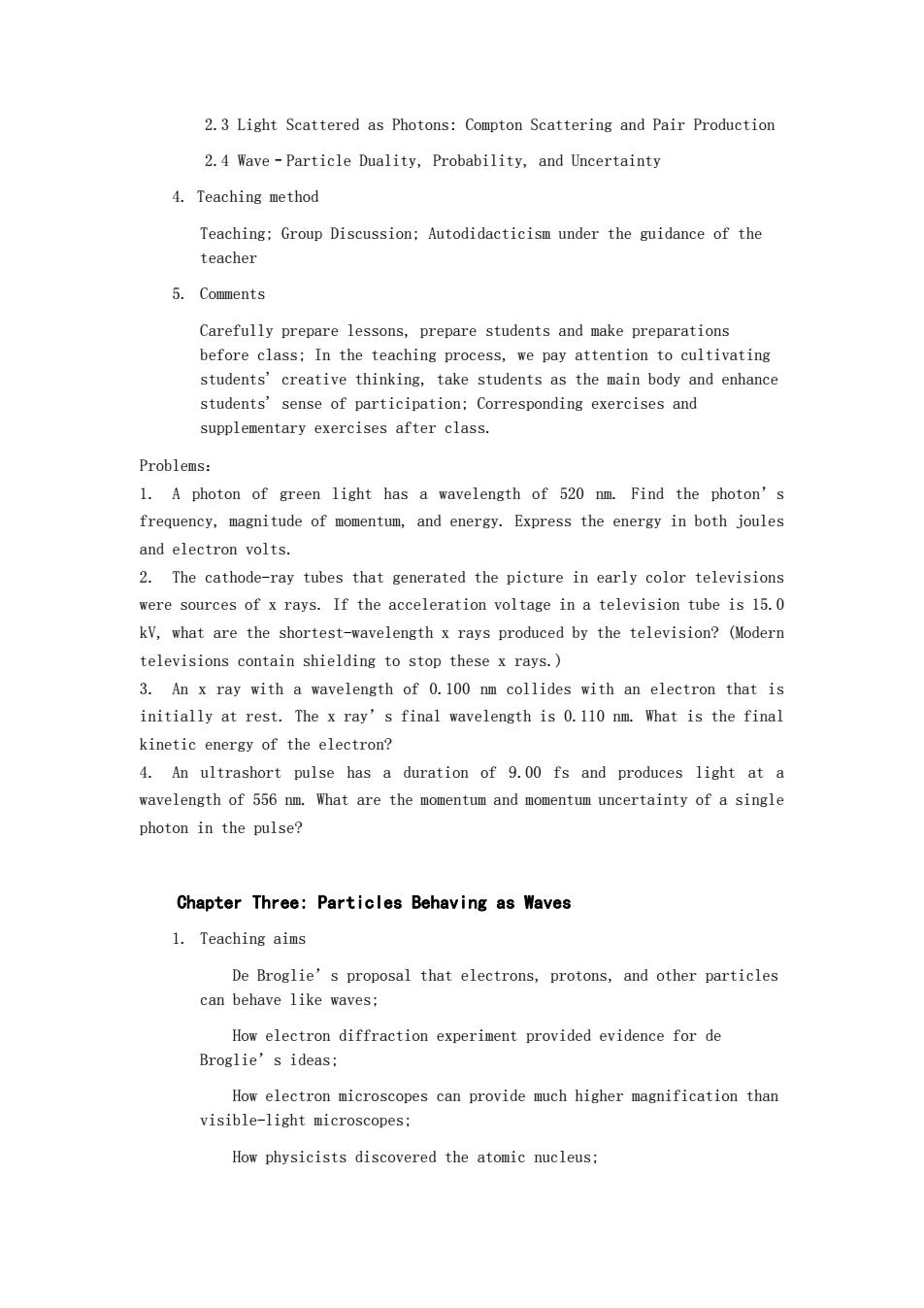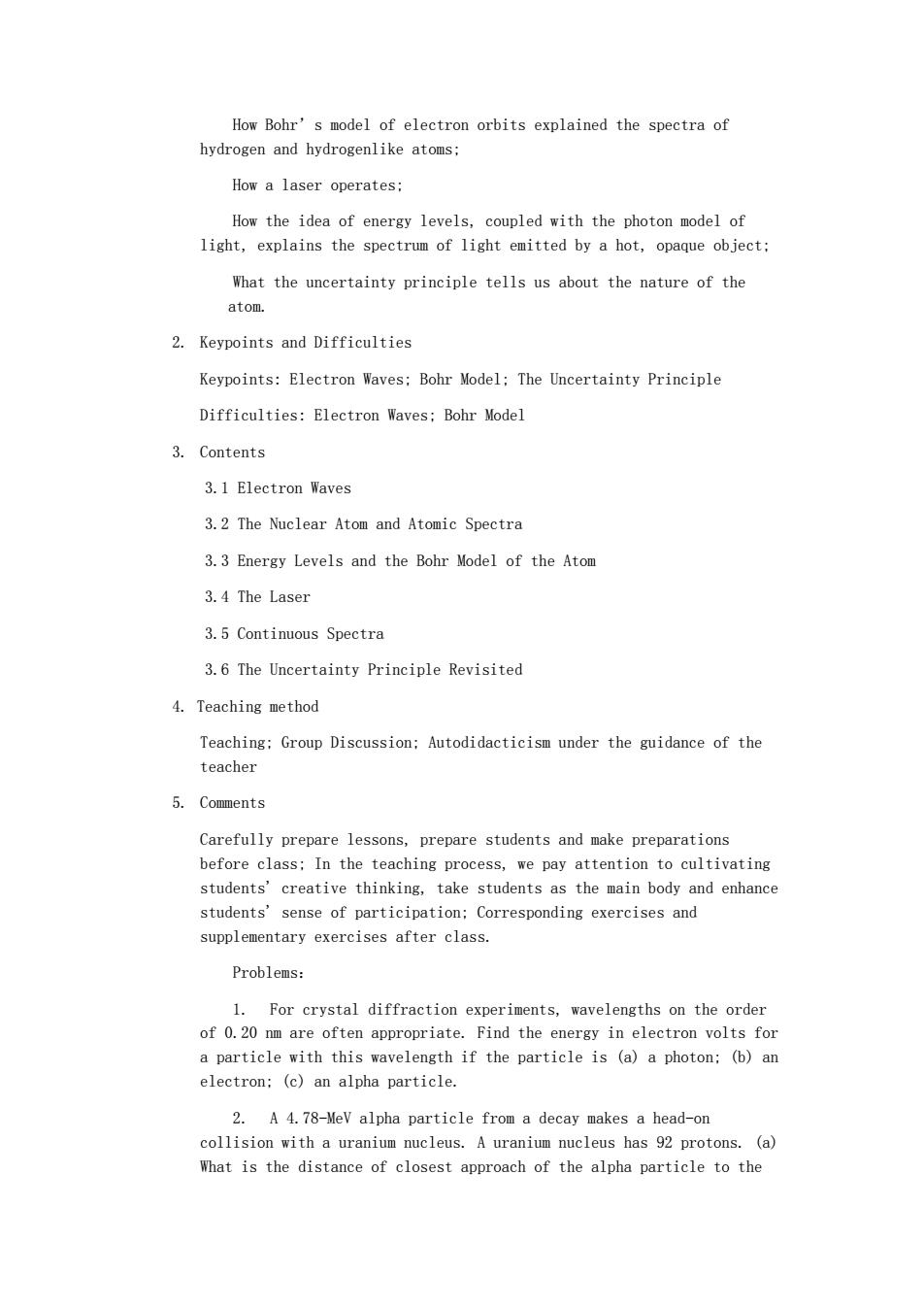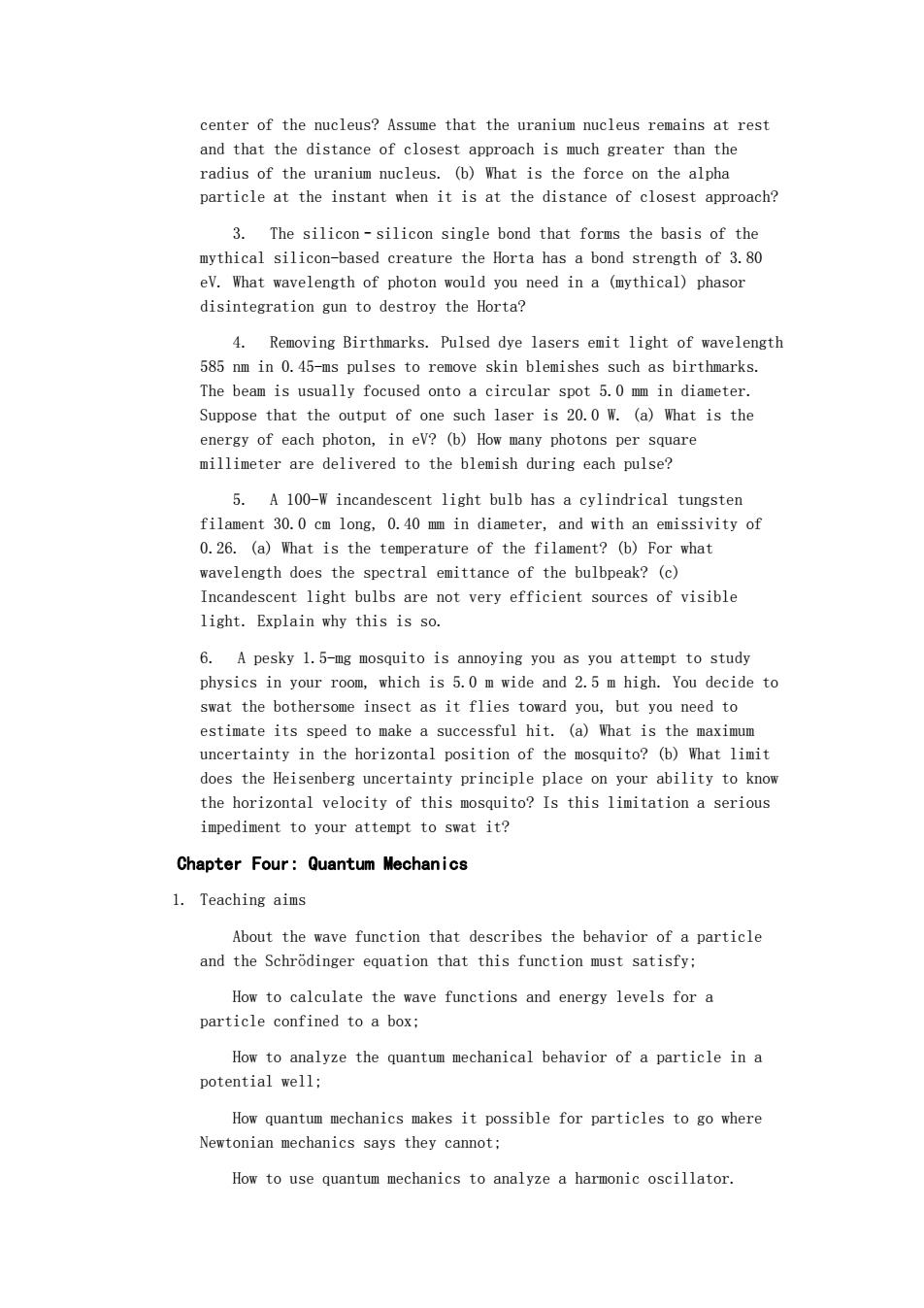
2.3 Light Scattered as Photons:Compton Scattering and Pair Production 2.4 Wave-Particle Duality,Probability,and Uncertainty 4.Teaching method Teaching:Group Discussion:Autodidacticism under the guidance of the teacher 5.Comments Carefully prepare lessons,prepare students and make preparations before class:In the teaching process,we pay attention to cultivating students'creative thinking,take students as the main body and enhance students'sense of participation:Corresponding exercises and supplementary exercises after class. Problems: 1.A photon of green light has a wavelength of 520 nm.Find the photon's frequency,magnitude of momentum,and energy.Express the energy in both joules and electron volts 2.The cathode-ray tubes that generated the picture in early color televisions were sources of x rays.If the acceleration voltage in a television tube is 15.0 kV,what are the shortest-wavelength x rays produced by the television?(Modern televisions contain shielding to stop these x rays.) 3.An x ray with a wavelength of 0.100 nm collides with an electron that is initially at rest.The x ray's final wavelength is 0.110 nm.What is the final kinetic energy of the electron? 4.An ultrashort pulse has a duration of 9.00 fs and produces light at a wavelength of 556 nm.What are the momentum and momentum uncertainty of a single photon in the pulse? Chapter Three:Particles Behaving as Waves 1.Teaching aims De Broglie's proposal that electrons,protons,and other particles can behave like waves; How electron diffraction experiment provided evidence for de Broglie's ideas; How electron microscopes can provide much higher magnification than visible-light microscopes: How physicists discovered the atomic nucleus
2.3 Light Scattered as Photons: Compton Scattering and Pair Production 2.4 Wave–Particle Duality, Probability, and Uncertainty 4. Teaching method Teaching; Group Discussion; Autodidacticism under the guidance of the teacher 5. Comments Carefully prepare lessons, prepare students and make preparations before class; In the teaching process, we pay attention to cultivating students' creative thinking, take students as the main body and enhance students' sense of participation; Corresponding exercises and supplementary exercises after class. Problems: 1. A photon of green light has a wavelength of 520 nm. Find the photon’s frequency, magnitude of momentum, and energy. Express the energy in both joules and electron volts. 2. The cathode-ray tubes that generated the picture in early color televisions were sources of x rays. If the acceleration voltage in a television tube is 15.0 kV, what are the shortest-wavelength x rays produced by the television? (Modern televisions contain shielding to stop these x rays.) 3. An x ray with a wavelength of 0.100 nm collides with an electron that is initially at rest. The x ray’s final wavelength is 0.110 nm. What is the final kinetic energy of the electron? 4. An ultrashort pulse has a duration of 9.00 fs and produces light at a wavelength of 556 nm. What are the momentum and momentum uncertainty of a single photon in the pulse? Chapter Three: Particles Behaving as Waves 1. Teaching aims De Broglie’s proposal that electrons, protons, and other particles can behave like waves; How electron diffraction experiment provided evidence for de Broglie’s ideas; How electron microscopes can provide much higher magnification than visible-light microscopes; How physicists discovered the atomic nucleus;

How Bohr's model of electron orbits explained the spectra of hydrogen and hydrogenlike atoms How a laser operates: How the idea of energy levels,coupled with the photon model of light,explains the spectrum of light emitted by a hot,opaque object What the uncertainty principle tells us about the nature of the atom 2.Keypoints and Difficulties Keypoints:Electron Waves:Bohr Model:The Uncertainty Principle Difficulties:Electron Waves:Bohr Model 3.Contents 3.1 Electron Waves 3.2 The Nuclear Atom and Atomic Spectra 3.3 Energy Levels and the Bohr Model of the Atom 3.4 The Laser 3.5 Continuous Spectra 3.6 The Uncertainty Principle revisited 4.Teaching metho Teaching:Group Discussion:Autodidacticism under the guidance of the teacher 5.Comments Carefully prepare lessons,prepare students and make preparations before class:In the teaching process,we pay attention to cultivating students'creative thinking,take students as the main body and enhance students sense of participation:Corresponding exercises and supplementary exercises after class. Problems: 1.For crystal diffraction experiments,wavelengths on the order of 0.20 nm are often appropriate.Find the energy in electron volts for a particle with this wavelength if the particle is (a)a photon:(b)an electron:(c)an alpha particle. 2.A 4.78-MeV alpha particle from a decay makes a head-on collision with a uranium nucleus.A uranium nucleus has 92 protons.(a) What is the distance of closest approach of the alpha particle to the
How Bohr’s model of electron orbits explained the spectra of hydrogen and hydrogenlike atoms; How a laser operates; How the idea of energy levels, coupled with the photon model of light, explains the spectrum of light emitted by a hot, opaque object; What the uncertainty principle tells us about the nature of the atom. 2. Keypoints and Difficulties Keypoints: Electron Waves; Bohr Model; The Uncertainty Principle Difficulties: Electron Waves; Bohr Model 3. Contents 3.1 Electron Waves 3.2 The Nuclear Atom and Atomic Spectra 3.3 Energy Levels and the Bohr Model of the Atom 3.4 The Laser 3.5 Continuous Spectra 3.6 The Uncertainty Principle Revisited 4. Teaching method Teaching; Group Discussion; Autodidacticism under the guidance of the teacher 5. Comments Carefully prepare lessons, prepare students and make preparations before class; In the teaching process, we pay attention to cultivating students' creative thinking, take students as the main body and enhance students' sense of participation; Corresponding exercises and supplementary exercises after class. Problems: 1. For crystal diffraction experiments, wavelengths on the order of 0.20 nm are often appropriate. Find the energy in electron volts for a particle with this wavelength if the particle is (a) a photon; (b) an electron; (c) an alpha particle. 2. A 4.78-MeV alpha particle from a decay makes a head-on collision with a uranium nucleus. A uranium nucleus has 92 protons. (a) What is the distance of closest approach of the alpha particle to the

center of the nucleus?Assume that the uranium nucleus remains at rest radius of the uranium nucleus. the alpha particle at the instant when it is at the distance of closest approach? 3.The silicon-silicon single bond that forms the basis of the mythical silicon-based creature the Horta has a bond strength of 3.80 eV.What wavelength of photon would you need in a (mythical)phasor disintegration gun to destroy the Horta? 4.Removing Birthmarks.Pulsed dye lasers emit light of wavelength 585 nm in 0.45-ms pulses to remove skin blemishes such as birthmarks. The beam is usually focused onto a circular spot 5.0 mm in diameter. Suppose that the output of one such laser is 20.0 W.(a)What is the energy of each photon,in ev?(b)How many photons per square millimeter are delivered to the blemish during each pulse? 5.A 100-W incandescent light bulb has a cylindrical tungsten filament 30.0 cm long,0.40 mm in diameter,and with an emissivity of 0.26.(hat is the temporarure of the)Po whot wavelength does the spectral emittance of Incandescent light bulbs are not very efficient sources of visible light.Explain why this is so. Yeleoto gtdy 6. physics e and 2.5m high. You decide to swat the bothersome insect as it flies toward you,but you need to estimate its speed to make a successful hit.(a)What is the maximum uncertainty in the horizontal position of the mosquito?(b)What limit does the Heisenberg uncertainty principle place on your ability to know the horizontal velocity of this mosquito?Is this limitationa serious impediment to your attempt to swat it? Chapter Four:Quantum Mechanics 1.Teaching aims About the wave function that describes the behavior of a particle and the Schrodinger equation that this function must satisfy: How to calculate the wave functions and energy levels for a particle confined to a box: How to analyze the quantum mechanical behavior of a particle in a potential well; How quantum mechanics makes it possible for particles to go where Newtonian mechanics says they cannot: How to use quantum mechanics to analyze a harmonic oscillator
center of the nucleus? Assume that the uranium nucleus remains at rest and that the distance of closest approach is much greater than the radius of the uranium nucleus. (b) What is the force on the alpha particle at the instant when it is at the distance of closest approach? 3. The silicon–silicon single bond that forms the basis of the mythical silicon-based creature the Horta has a bond strength of 3.80 eV. What wavelength of photon would you need in a (mythical) phasor disintegration gun to destroy the Horta? 4. Removing Birthmarks. Pulsed dye lasers emit light of wavelength 585 nm in 0.45-ms pulses to remove skin blemishes such as birthmarks. The beam is usually focused onto a circular spot 5.0 mm in diameter. Suppose that the output of one such laser is 20.0 W. (a) What is the energy of each photon, in eV? (b) How many photons per square millimeter are delivered to the blemish during each pulse? 5. A 100-W incandescent light bulb has a cylindrical tungsten filament 30.0 cm long, 0.40 mm in diameter, and with an emissivity of 0.26. (a) What is the temperature of the filament? (b) For what wavelength does the spectral emittance of the bulbpeak? (c) Incandescent light bulbs are not very efficient sources of visible light. Explain why this is so. 6. A pesky 1.5-mg mosquito is annoying you as you attempt to study physics in your room, which is 5.0 m wide and 2.5 m high. You decide to swat the bothersome insect as it flies toward you, but you need to estimate its speed to make a successful hit. (a) What is the maximum uncertainty in the horizontal position of the mosquito? (b) What limit does the Heisenberg uncertainty principle place on your ability to know the horizontal velocity of this mosquito? Is this limitation a serious impediment to your attempt to swat it? Chapter Four: Quantum Mechanics 1. Teaching aims About the wave function that describes the behavior of a particle and the Schrödinger equation that this function must satisfy; How to calculate the wave functions and energy levels for a particle confined to a box; How to analyze the quantum mechanical behavior of a particle in a potential well; How quantum mechanics makes it possible for particles to go where Newtonian mechanics says they cannot; How to use quantum mechanics to analyze a harmonic oscillator